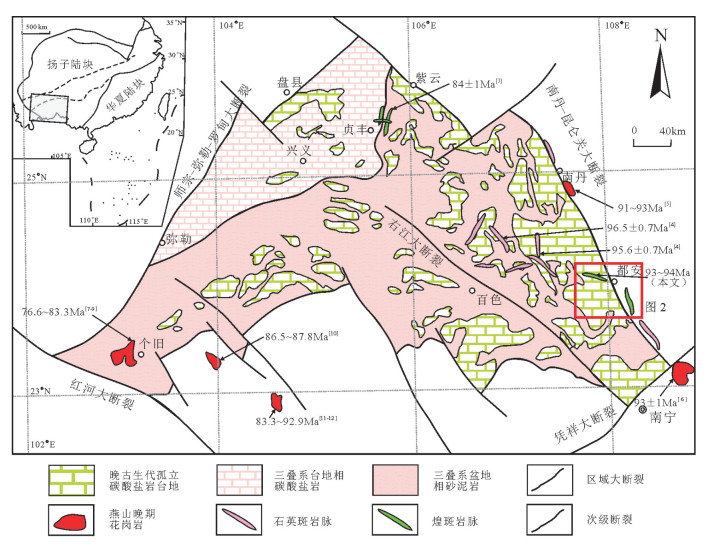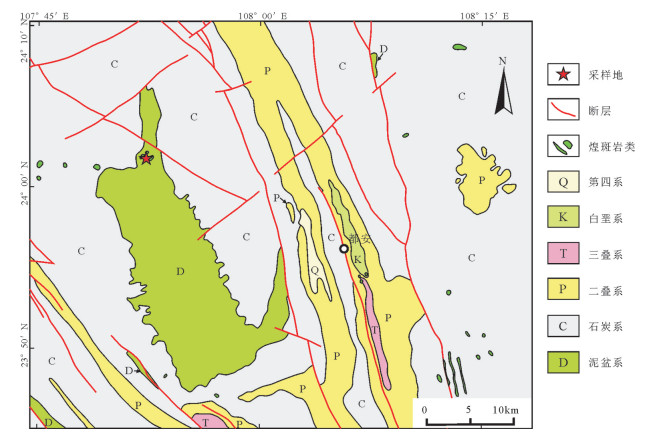Phlogopite 40Ar/39Ar dating of the lamproite veins in Du'an County, central Guangxi and its tectonic significance
-
摘要:
右江褶皱带地处扬子陆块和华夏陆块的结合部位,区内广泛发育以基性-超基性岩墙群和超酸性岩脉为主的燕山晚期双峰式岩浆活动。对桂中都安地区的金云钾镁煌斑岩脉进行了金云母40Ar/39Ar法测年,斑晶和基质金云母样品均给出了较一致的坪年龄,分别为93.6±0.6Ma和92.9±0.6Ma,相应的等时线年龄分别为93.4±0.9Ma和92.7±0.8Ma,上述年龄代表了岩脉的侵位年龄。结合区内报道的同期年代学资料,进一步证明右江褶皱带及其周缘晚白垩世双峰式岩浆活动响应了华南地区燕山晚期的构造转换事件及随后大规模的岩石圈伸展减薄。
-
关键词:
- 钾镁煌斑岩 /
- 金云母40Ar-39Ar年龄 /
- 燕山晚期 /
- 岩石圈伸展减薄 /
- 华南
Abstract:The Youjiang Fold Belt is located in the connection region between Yangtze Block and Cathaysia Block. It is characterized by Late Yanshanian bimodal magmatic activities and consists of basic-ultrabasic dyke swarms and ultra-acid rock veins. In this study, the phlogopite 40Ar/39Ar dating of phenocryst and matrix from phlogopite lamproite veins, which are located in the Du' an County of central Guangxi, yielded two plateau ages of 93.6±0.6Ma, 92.9±0.6Ma and two isochron ages of 93.4±0.9Ma, 92.7±0.8Ma, respectively. These ages are interpreted as the emplacement age for phlogopite lamproite veins. The new results obtained by the authors in junction with the coeval magmatic events further reveal that the voluminous Late Cretaceous bimodal magmatic activities occurred in the Youjiang Fold Belt as well as its peripheral regions in response to the Late Yanshanian tectonic transition and subsequent lithospheric thinning and extension in South China.
-
致谢: 野外地质工作得到广西区域地质调查研究院和广西地质调查院同事的极力协助,审稿专家对本文提出宝贵的修改意见和建议,在此一并表示衷心感谢。
-
图 1 右江褶皱带区域地质简图及燕山晚期岩浆分布(据参考文献[4]修改)
Figure 1. Geological sketch map of the Youjiang Fold Belt and the Late Yanshanian magmatic activities
图 2 桂中都安地区煌斑岩类分布(据1:20万田东幅地质图①修改)
Figure 2. The distribution of the lamproite veins in Du'an County, central Guangxi
表 1 桂中都安金云钾镁煌斑岩金云母40Ar/39Ar测年结果
Table 1 Phlogopite 40Ar/39Ar dating results of the lamproite veins in Du'an County, central Guangxi
T/℃ 40Ar/39Ar 37Ar/39Ar 36Ar/39Ar 40Ar*/39Ark %40Ar* %39Ark 年龄/Ma 2σ 12HW03(斑晶金云母), J=0.0048500± 0.0000121,Tp坪年龄=93.6土0.6Ma 680 17.50031 0.08496 0.02699 9.532333 54.47 1.11 82 25 760 12.01905 0.02690 0.00368 10.933323 90.96 3.28 93.4 2.9 800 11.45264 0.00649 0.00170 10.950416 95.61 12.55 93.6 1.1 840 11.23485 0.00522 0.00101 10.936863 97.35 17.92 93.46 0.88 870 11.12323 0.00766 0.00080 10.887775 97.88 13.67 93.1 1.6 900 11.21829 0.01707 0.00099 10.926589 97.40 11.14 93.4 1.6 940 11.42351 0.01096 0.00163 10.942528 95.79 10.65 93.5 1.2 980 11.89086 0.01047 0.00282 11.058184 93.00 10.32 94.5 2.0 1020 12.19888 0.01225 0.00387 11.056369 90.63 10.25 94.5 1.4 1120 12.63323 0.02538 0.00582 10.916255 86.41 5.91 93.3 2.3 1320 13.47338 0.02370 0.00890 10.845540 80.49 3.20 92.7 3.4 12HW03m(基质金云母), J=0.0048640 ±0.0000122,Tp坪年龄=92.9±0.6Ma 650 17.93117 6.94610 0.03017 9.624620 53.36 0.59 83 10 700 12.44258 2.81760 0.00564 11.026463 88.41 2.28 94.5 4.2 740 11.42137 1.66770 0.00206 10.961556 95.84 3.68 93.9 2.6 780 11.15560 0.53145 0.00112 10.872705 97.42 9.22 93.2 1.2 820 10.95499 0.30736 0.00071 10.772593 98.31 26.13 92.35 0.84 850 11.05109 0.29313 0.00077 10.850162 98.16 18.64 93.00 0.93 880 11.22780 0.59770 0.00143 10.857494 96.65 10.94 93.1 1.1 910 11.57964 0.90524 0.00277 10.841676 93.55 6.89 92.9 1.5 950 12.47944 0.97344 0.00586 10.835396 86.75 5.39 92.9 1.7 990 13.08713 2.16358 0.00911 10.585785 80.74 4.27 90.8 3.2 1030 12.99875 1.26241 0.00910 10.422390 80.09 4.14 89.4 2.7 1070 13.34029 2.05381 0.00890 10.892926 81.51 3.21 93.4 2.572 1110 12.90411 2.46550 0.00728 10.972992 84.86 2.23 94.0 4.4 1150 12.63498 5.08003 0.00713 10.979802 86.52 1.39 94.1 7. 5 1270 13.21722 8.35924 0.01066 10.808990 81.20 1.01 93 11 表 2 右江褶皱带燕山晚期岩浆岩记录
Table 2 The Late Yanshanian magmatic records in the Youjiang Fold Belt
位置 岩性 年龄/Ma 测试方法 资料来源 贵州贞丰县白层 基性-超基性岩墙 84±1 SHRIMP锆石U-Pb法 [3] 广西凤山县弄黄 石英斑岩脉 96.5±0.7 白云母斑晶Ar-Ar法 广西巴马县县城东 石英斑岩脉 95.6±0.7 白云母斑晶Ar-Ar法 [4] 广西都安县保安 煌斑岩墙 99.02±0.78 金云母Ar-Ar法 广西都安县东庙 煌斑岩脉 93.6±0.6;92.9±0.6 金云母Ar-Ar法 本文 广西大厂龙箱盖 黑云母花岗岩 93±1 SHRIMP锆石U-Pb法 [5] 斑状黑云母花岗岩 91±1 花岗斑岩墙 91±1 闪长玢岩墙 91±1 广西昆仑关 斑状黑云母花岗岩 93±1 LA-ICP-MS锆石U-Pb法 [6] 云南个旧 白云山碱性岩 76.6±3.6 LA-ICP-MS锆石U-Pb法 [9] 老厂东煌斑岩 77.2±2.4 老卡花岗岩 85±0.85 龙岔河斑状花岗岩 82.0-83.2 LA-ICP-MS和SHRIMP锆石U-Pb法 [8] 马松似斑状花岗岩 82.8±1.7 老厂似斑状花岗岩 83.3±1.6 白沙冲等粒花岗岩 77.4±2.5 云南薄竹山 雷达站屮细粒含斑黑云二长花岗岩 86.51±0.52 LA-ICP-MS锆石U-Pb法 [10] 所作底斑状黑云二长花岗岩 87.54±0.65 洋芋树斑状黑云二长花岗岩 87.83±0.39 云南都龙老君山 黑云母花岗岩 92.9±1.9 SHRIMP锆石U-Pb法 [11] 86.9±1.4 86.9±1.4 SHRIMP锆石U-Pb法 [12] 93.6±2.3 LA-ICP-MS锆石U-Pb法 [20] 90.03±0.67 90.9±1.6 89.24±0.55 93.1±1.6 93.1±1.6 88.9±11 -
张岳桥, 董树文, 李建华, 等.华南中生代大地构造研究新进展[J].地球学报, 2012, 33(3):257-279. http://d.old.wanfangdata.com.cn/Periodical/dqxb201203001 李三忠, 臧艺博, 王鹏程, 等.华南中生代构造转换和古太平洋俯冲启动[J].地学前缘, 2017, (4):213-225. http://d.old.wanfangdata.com.cn/Periodical/dxqy201704020 陈懋弘, 章伟, 杨宗喜, 等.黔西南白层超基性岩墙锆石SHRIMP U-Pb年龄和Hf同位素组成研究[J].矿床地质, 2009, 28(3):240-250. doi: 10.3969/j.issn.0258-7106.2009.03.002 陈懋弘, 陆刚, 李新华.桂西北地区石英斑岩脉白云母40Ar/39Ar年龄及其地质意义[J].高校地质学报, 2012, 18(1):106-116. doi: 10.3969/j.issn.1006-7493.2012.01.009 蔡明海, 何龙清, 刘国庆, 等.广西大厂锡矿田侵入岩SHRIMP锆石U-Pb年龄及其意义[J].地质论评, 2006, 52(3):409-414. doi: 10.3321/j.issn:0371-5736.2006.03.023 谭俊, 魏俊浩, 李水如, 等.广西昆仑关A型花岗岩地球化学特征及构造意义[J].地球科学-中国地质大学学报, 2008, 33(6):743-754. doi: 10.3321/j.issn:1000-2383.2008.06.002 程彦博, 毛景文, 谢桂青, 等.云南个旧老厂-卡房花岗岩体成因初探:锆石U-Pb年代学和岩石地球化学约束[J].地质学报, 2008, 81(11):1478-1493. doi: 10.3321/j.issn:0001-5717.2008.11.003 程彦博, 毛景文, 谢桂青, 等.与云南个旧超大型锡矿床有关的花岗岩锆石U-Pb定年及意义[J].矿床地质, 2009, 28(3):297-312. doi: 10.3969/j.issn.0258-7106.2009.03.006 程彦博, 毛景文, 陈懋弘, 等.云南个旧锡矿田碱性岩和煌斑岩LA-lCP-MS锆石U-Pb测年及其地质意义[J].中国地质, 2008, 35(6):1138-1149. doi: 10.3969/j.issn.1000-3657.2008.06.011 程彦博, 毛景文, 陈小林, 等.滇东南薄竹山花岗岩的LA-ICPMS锆石U-Pb定年及地质意义[J].吉林大学学报(地), 2010, 40(4):869-878. http://www.cnki.com.cn/Article/CJFDTotal-CCDZ201004018.htm 刘玉平, 李正祥, 李惠民, 等.都龙锡锌矿床锡石和锆石U-Pb年代学:滇东南白垩纪大规模花岗岩成岩-成矿事件[J].岩石学报, 2007, 23(5):967-976. http://d.old.wanfangdata.com.cn/Periodical/ysxb98200705010 冯佳睿, 毛景文, 裴荣富, 等.云南瓦渣钨矿区老君山花岗岩体的SHRIMP锆石U-Pb定年、地球化学特征及成因探讨[J].岩石学报, 2010, 26(3):845-857. http://d.old.wanfangdata.com.cn/Periodical/ysxb98201003017 曾允孚, 刘文均, 陈洪德, 等.华南右江复合盆地的沉积构造演化[J].地质学报, 1995, (2):113-124. http://www.wanfangdata.com.cn/details/detail.do?_type=perio&id=QK199500063473 刘观亮, 汪雄武, 吕学森.大洪山钾镁煌斑岩岩石学、矿物学特征及含矿性研究[M].北京:地质出版社, 1993. Ludwig K R. User's manual for Isoplot, EX Version 3.0:A Geochronological Toolkit for Microsoft Excel[M]. Berkeley Geochronology Center, Special Publication, 2003.
陈文, 张彦, 张岳桥, 等.青藏高原东南缘晚新生代幕式抬升作用的Ar-Ar热年代学证据[J].岩石学报, 2006, 22(4):867-872. http://d.old.wanfangdata.com.cn/Periodical/ysxb98200604010 李志昌, 路远发, 黄圭成.放射性同位素地质学方法与进展[M].武汉:中国地质大学出版社, 2004. 王登红, 陈毓川, 陈文, 等.广西南丹大厂超大型锡多金属矿床的成矿时代[J].地质学报, 2004, 78(1):132-138. doi: 10.3321/j.issn:0001-5717.2004.01.015 蔡明海, 梁婷, 吴德成.广西大厂锡多金属矿田亢马矿床地质特征及成矿时代[J].地质学报, 2005, 79(2):262-268. doi: 10.3321/j.issn:0001-5717.2005.02.012 刘艳宾, 莫宣学, 张达, 等.滇东南老君山地区晚白垩世花岗岩的成因[J].岩石学报, 2014, 30(11):3271-3286. http://d.old.wanfangdata.com.cn/Periodical/ysxb98201411013 董树文, 张岳桥, 陈宣华, 等.晚侏罗世东亚多向汇聚构造体系的形成与变形特征[J].地球学报, 2008, 29(3):306-317. doi: 10.3321/j.issn:1006-3021.2008.03.005 Mao J R, Ye H M, Liu K, et al. The Indosinian collision-extension event between the South China Block and the PalaeoPacific plate:Evidence from Indosinian alkaline granitic rocks in Dashuang, eastern Zhejiang, South China[J]. Lithos, 2013, 172/173(4):81-97. https://www.researchgate.net/publication/257927792_The_Indosinian_collision-extension_event_between_the_South_China_Block_and_the_Palaeo-Pacific_plate_Evidence_from_Indosinian_alkaline_granitic_rocks_in_Dashuang_eastern_Zhejiang_South_China
Mao J R, Li Z L, Ye H M. Mesozoic tectono-magmatic activities in South China:Retrospect and prospect[J]. Science in China (Ser. D), 2014, 57(12):2853-2877. doi: 10.1007/s11430-014-5006-1
吴福元, 葛文春, 孙德有, 等.中国东部岩石圈减薄研究中的几个问题[J].地学前缘, 2003, 10(3):51-60. doi: 10.3321/j.issn:1005-2321.2003.03.004 谢桂青, 毛景文, 胡瑞忠, 等.中国东南部中-新生代地球动力学背景若干问题的探讨[J].地质论评, 2005, 51(6):613-620. doi: 10.3321/j.issn:0371-5736.2005.06.002 Li Z X, Li X H. Formation of the 1300km-wide intracontinental orogen and postorogenic magmatic province in Mesozoic South China:A flat-slab subduction model[J]. Geology, 2007, 35(2):179-182. http://cn.bing.com/academic/profile?id=1ad61887b098119fe159438fa5db6660&encoded=0&v=paper_preview&mkt=zh-cn
Wang Y J, Fan W M, Zhang G W, et al. Phanerozoic tectonics of the South China Block:Key observations and controversies[J]. Gondwana Research, 2013, 23(4):1273-1305. doi: 10.1016/j.gr.2012.02.019
毛建仁.华南燕山期岩浆-成矿作用大爆发与陆内造山运动[C]//中国地质学会.中国地质学会2015学术年会论文摘要汇编(中册).2015. 蔡明海, 梁婷, 吴德成, 等.广西丹池成矿带构造特征及其控矿作用[J].地质与勘探, 2004, 40(6):5-10. http://d.old.wanfangdata.com.cn/Periodical/dzykt200406002 Li X Y, Zheng J P, Ma Q, et al. From enriched to depleted mantle:Evidence from Cretaceous lamprophyres and Paleogene basaltic rocks in eastern and central Guangxi Province, western Cathaysia block of South China[J]. Lithos, 2014, 184/187(1):300-313. http://cn.bing.com/academic/profile?id=b77191ee7fc7d9675e969950b2691348&encoded=0&v=paper_preview&mkt=zh-cn
广西壮族自治区地质局.1:20万田东幅区域地质调查报告.1974. 陆刚,黄祥林,李文强,等.1:25万南丹幅区域地质调查报告.南广西壮族自治区地质调查院,2013.




 下载:
下载:



